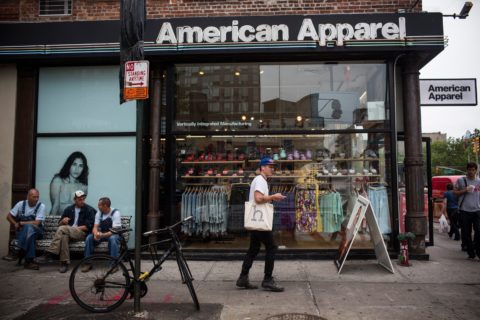R.I.P. American Apparel: The Rise and Fall of a Generation-Defining Brand
Never Forget.
It’s time to say goodbye to the retailer that brought disco pants, deep V-necks and triple stripe tube socks to the masses. It looks like American Apparel, the “Made in USA” brand made famous for their NSFW advertisements and controversial CEO, will soon close its doors for good. It was announced last week that the Bankruptcy Court has approved Gildan Activewar’s $88 million bid to purchase the California-based clothing company. Gildan, a Canadian manufacturer whose logo you’ll recognize from your favourite Life of Pablo merch, will not be absorbing American Apparel’s 110 U.S. retail locations in the acquisition. What does this mean for your go-to bodysuit and basics shop? RUN—and stock up—because it’s not looking good.
To those who have followed the downfall of AA (or who have shopped their deeply discounted sale racks), this news won’t come as a surprise. For the past several years, lawsuits, an immigration crackdown and the growing trend towards fast-fashion have burdened the business’ bottom line. After a long string of public leadership scandals, bankruptcy claims, and financial struggle, it looks like American Apparel has run out of second chances. We take a look back at the 27-year history of a brand that pushed boundaries, broke barriers and became the fashion headquarters of the millennial hipster movement.

1989: Montreal’s own Dov Charney starts a t-shirt selling operation out of his dorm room at Tufts University. Within a year, Charney has dropped out of school, taken a $10,000 loan from his father and pursued a full-time career as an apparel-making entrepreneur.
1997: Charney settles his manufacturing and wholesale business in Los Angeles. Since its earliest days, American Apparel has set out to challenge the exploitative labour practices common to garment manufacturing. Charney’s commitment to sell high quality American-made goods was profitable and the ethical appeal caught the eye of a growing market—the conscious consumer.
2003: After experiencing early success selling to emerging labels and screen printers, Charney made the decision to expand into retail. In their first year, American Apparel opened stores in Los Angeles, New York and Montreal. Within two years, AA went on to open another fifty locations and was generating $250 million (USD) in annual sales.
2011: A former American Apparel employee accuses Dov Charney of sexual assault, and later that year Britain’s ASA (Advertising Standard Authority) bans several American Apparel ads for being “pornographic, exploitative of women and inappropriately sexualizing young women.” The brand’s barely-there campaigns, once viewed as artsy and subversive, began to appear creepy after allegations of employee harassment become public.
2014: Amidst public scandal and financial loss, American Apparel’s Board of Directors ousts Charney from the company. The company announces Paula Schneider, an industry veteran, as the new CEO.
2016: American Apparel files for Chapter 11 bankruptcy for the second time in 15 months. Gildan Activewear agrees to purchase the brand’s intellectual property rights, but passes on their retail assets and manufacturing facilities.
2017: American Apparel prepares to close up shop, and begins to lay off approximately 2,400 employees.








